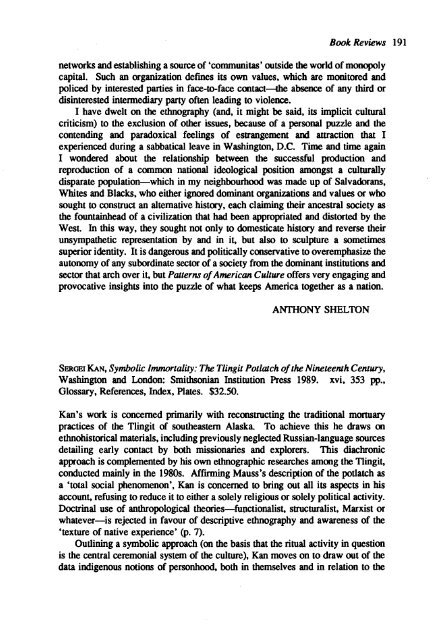1991 No. 1 CONTENTS - Institute of Social and Cultural ...
1991 No. 1 CONTENTS - Institute of Social and Cultural ...
1991 No. 1 CONTENTS - Institute of Social and Cultural ...
You also want an ePaper? Increase the reach of your titles
YUMPU automatically turns print PDFs into web optimized ePapers that Google loves.
Book Reviews 191<br />
networks <strong>and</strong> establishing a source <strong>of</strong> 'communitas' outside the world <strong>of</strong> monopoly<br />
capital. Such an organization defines its own values, which are monitored <strong>and</strong><br />
policed by interested parties in face-to-face cmtact-the absence <strong>of</strong> any third or<br />
disinterested intennediary party <strong>of</strong>ten leading to violence.<br />
I have dwelt on the ethnography (<strong>and</strong>, it might be said, its implicit cultural<br />
criticism) to the exclusion <strong>of</strong> other issues, because <strong>of</strong> a personal puzzle <strong>and</strong> the<br />
contending <strong>and</strong> paradoxical feelings <strong>of</strong> estrangement <strong>and</strong> attraction that I<br />
experienced during a sabbatical leave in Washington, D.e. Time <strong>and</strong> time again<br />
I wondered about the relationship between the successful production <strong>and</strong><br />
reproduction <strong>of</strong> a common national ideological position amongst a culturally<br />
disparate population-which in my neighbourhood was made up <strong>of</strong> Salvadorans,<br />
Whites <strong>and</strong> Blacks, who either ignored dominant organizations <strong>and</strong> values or who<br />
sought to construct an alternative history, each claiming their ancestral society as<br />
the fountainhead <strong>of</strong> a civilization that had been appropriated <strong>and</strong> distorted by the<br />
West. In this way, they sought not only to domesticate history <strong>and</strong> reverse their<br />
unsympathetic representation by <strong>and</strong> in it, but also to SCUlpture a sometimes<br />
superior identity. It is dangerous <strong>and</strong> politically conservative to overemphasize the<br />
autonomy <strong>of</strong> any subordinate sector <strong>of</strong> a society from the dominant institutions <strong>and</strong><br />
sector that arch over it, but Patterns <strong>of</strong> American Culture <strong>of</strong>fers very engaging <strong>and</strong><br />
provocative insights into the puzzle <strong>of</strong> what keeps America together as a nation.<br />
ANTHONY SHELTON<br />
SERGEI KAN, Symbolic Immortality: The Tlingit Potlatch <strong>of</strong> the Nineteenth Century,<br />
Washington <strong>and</strong> London: Smithsonian Institution Press 1989. xvi, 353 pp.,<br />
Glossary, References, Index, Plates. $32.50.<br />
Kan's work is concerned primarily with recmstructing the traditional mortuary<br />
practices <strong>of</strong> the Tlingit <strong>of</strong> southeastern Alaska To achieve this he draws on<br />
ethnohistorical materials, including previously neglected Russian-language sources<br />
detailing early contact by both missionaries <strong>and</strong> explorers. This diachronic<br />
approach is complemented by his own ethnographic researches among the Tlingit,<br />
conducted mainly in the 19808. Affmning Mauss's description <strong>of</strong> the potlatch as<br />
a 'total social phenomenon', Kan is concerned to bring out all its aspects in his<br />
account, refusing to reduce it to either a solely religious or solely political activity.<br />
Doctrinal use <strong>of</strong> anthropological theories-fupctionalist, structuralist, Marxist or<br />
whatever-is rejected in favour <strong>of</strong> descriptive ethnography <strong>and</strong> awareness <strong>of</strong> the<br />
'texture <strong>of</strong> native experience' (p. 7).<br />
Outlining a symbolic approach (on the basis that the ritual activity in question<br />
is the central ceremonial system <strong>of</strong> the culture), Kan moves on to draw out <strong>of</strong> the<br />
data indigenous notions <strong>of</strong> personhood, both in themselves <strong>and</strong> in relation to the
















